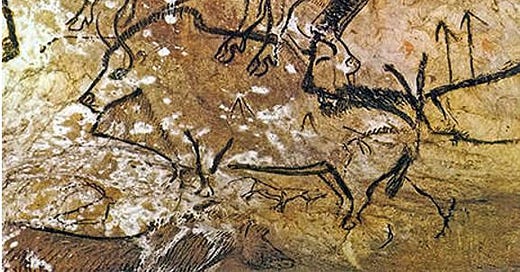Hi all,
Austin here with the latest Nothing.Here bonus installment. This time around I’m sending you a short essay – it was inspired by Barthes’ Mythologies, which I recently read in a weekend and found perfectly suited to my attention span and the brief little pockets of time available to me. I was aiming for a kind of Herzogian “ecstatic truth” with this essay – I can’t say I entirely believe everything I’ve written, but it certainly felt more convincing and true as I wrote it, something like hypnotising myself. I hope you enjoy it, and if you have any comments, please hit reply and let me know what’s on your mind. Have a great week, and we’ll talk to you again soon.
***
Cartoon Metaphysics: Written in The Flicker
By Austin Armatys
Our limbs were elongated by the flames, stretched and contorted into weird dimensions, climbing the walls and taking on the appearances of other things: animals, faces, landscapes. We gazed at the cave walls and watched the light deform our bodies, deform reality. Deep within us, we knew this process by its true name: Potential.
The future once promised to us was a thing of homogeneity and literal uniformity: global government, mandatory jumpsuits, Soylent Green for breakfast, lunch and dinner. But what we got instead was decidedly Not That. The 20th century splintered the modern world, destroying any centrality of meaning. Now, a couple of decades into the 21st, we’re living through another brutal fear spiral, people once again putting their faith in populists that comfort with promised returns to mythic pasts. But it won’t work - those imaginary pasts are dead, and their mythic futures died with them.
The future as we can now envision it often appears as clusters and connections, nodes and nanobots, or as Nyx Land put it, a “sexless, genderless slime swarmachine”. But I’d like to propose a different vehicle for understanding a future that is trending towards fragmentation and dissolution: The Cartoon.
To help me explain why, let’s go back to the cave.

Cave art began as a way for our ancestors to capture and understand the world around them. The paintings of horses, bison and mammoths in Niaux (pictured above) and Le Portel in Ariège are located in spaces that have peculiar acoustic properties – ancient theatres where reality could be made porous, a place perfect for ritual derangement of the senses. In the undulating chants and flickering fires the mammoths miraculously moved, the bison stirred, and our fingers stretched into the future. We watched in awe, and through observation of this spectacle an understanding of our innate potential was obtained. This was the way things were, but it wasn’t how they had to be. These early “cartoons” were an attempt to capture our immediate environment, but also functioned as a way to conceptualise breaking free of its limits.
We continued to interact with the external world through art, but gradually denied this process' magical (that is to say “reality-altering”) properties. The Enlightenment encouraged a rationality that framed science as the most effective tool in our quest to tame the world, but civilisation nonetheless continued to reap the strange fruits planted in and by our imaginations. Symbol and meaning, intent and effect, forever entwined. The ritual we call “art” retained its power, but we thought ourselves foolish to directly acknowledge its influence. Newton slept.
But The Cartoon remained with us, its powers growing. The images stayed on the walls, and although their fidelity improved, the basic principles remained the same: the flicker made movement, the movement made meaning. The form of the world was rendered malleable by the animator’s hand, pencil and brush the ultimate ontological flatteners. Physics, physiology, time – the cartoon enchanted us by destroying limitations, clearly revealing how the world was contained within us, and how we were contained within the world.
The anthropomorphic creature – elemental in its simplicity, basic shapes rendered in black ink - raises its hand, and the hand becomes a hammer. The constantly morphing and shifting bodies of the cartoon echo our quest to weaken (and ultimately dissolve) the barrier between the human and the not-. The hammer is a tool, yes, and while it possesses undeniable material attributes, the hammer was also born in the mind, first conceived in the flicker of cave light, in the spark of synapses. In the realm of the cartoon, the hammer springs from the hand fully formed because it is the hand.
It was us before it was itself.
We are the hammer.
Now: We lower the visor and raise a hand. It shoots up the wall, running along each surface, wrapping around the room. We float through worlds – this one and others – manipulating space-time with minimal gestures, all while sitting mostly still. We shape these new realities and think and prod and dream and dissect, moving our hands to measure the effect of small movements. We build more hammers. The wall is still there, even if we can’t see it. Maybe one day we’ll shed the need for it entirely, freed finally from physicality, pure amorphous symbol realised in our far-future descendants – probably the lineage of a banker with a bunker and a small army of mercenaries. Whether it is achieved through CRISPR or nanotech or a wraparound always-on augmented reality, humanity was always heading towards a union with the cartoon. It was our destiny, and we saw it written in the flicker.
***




Brilliant